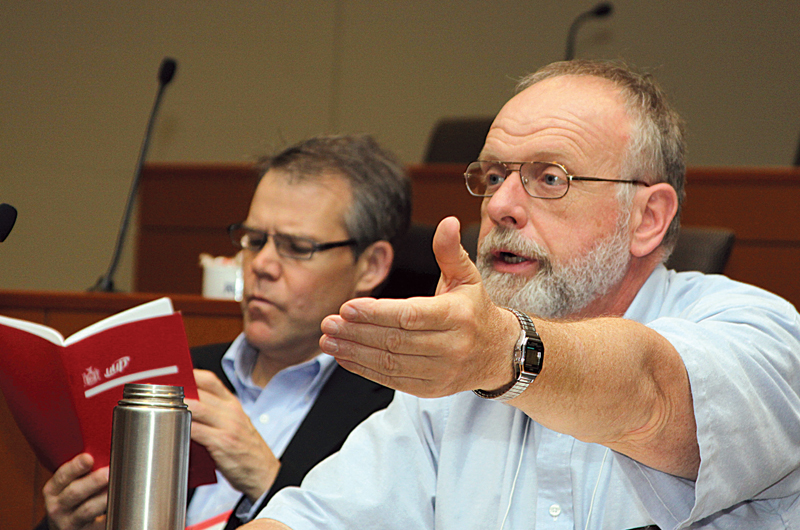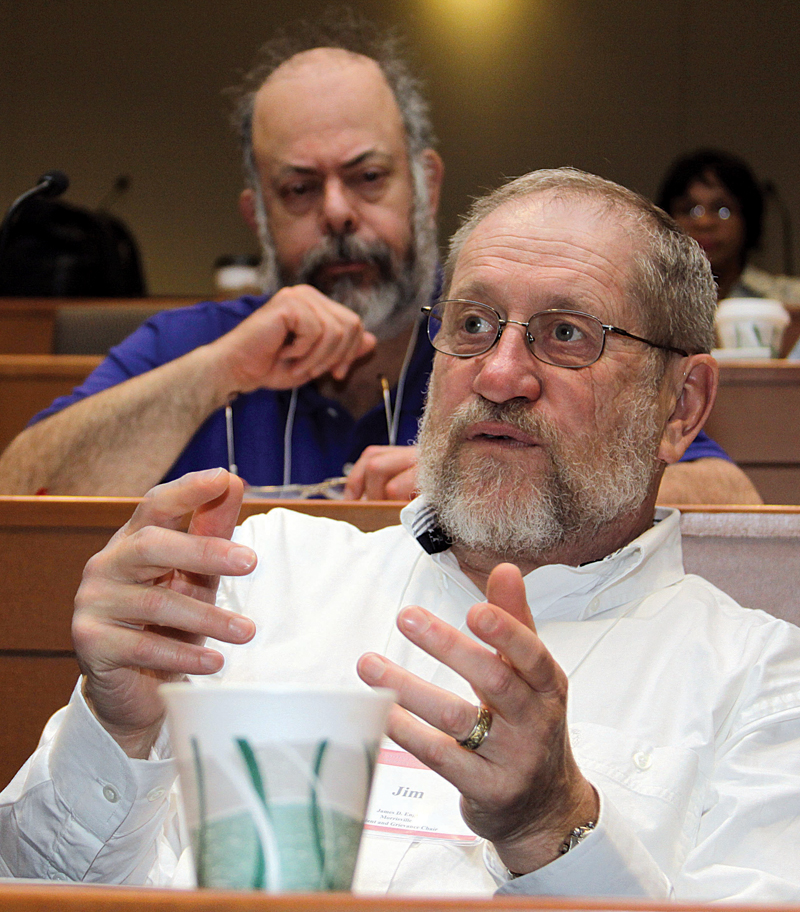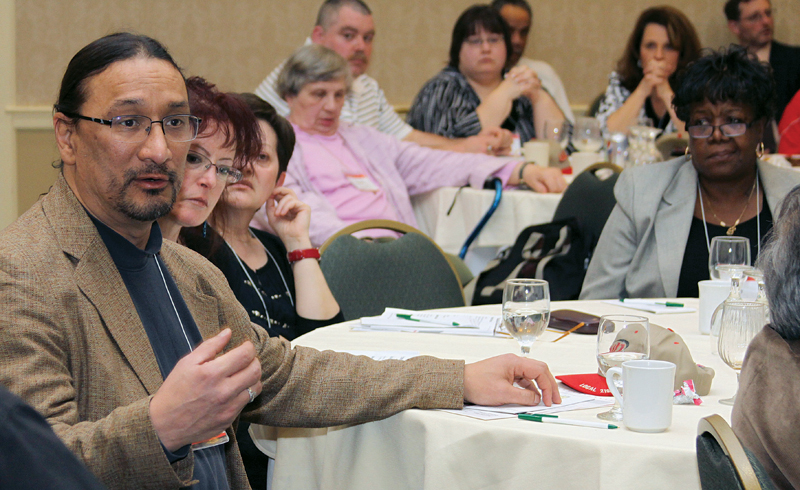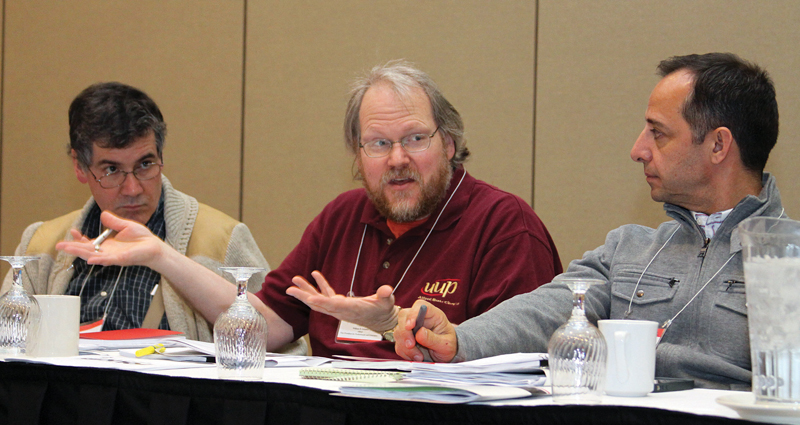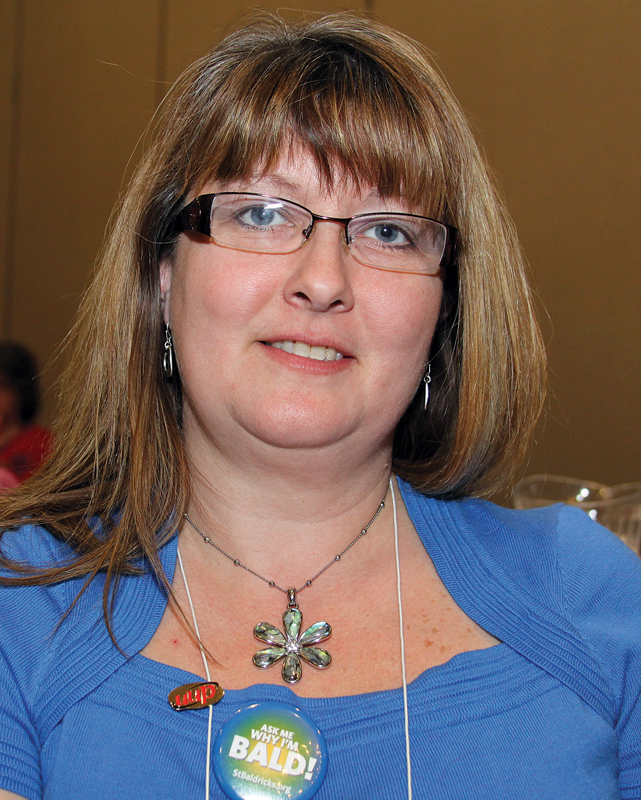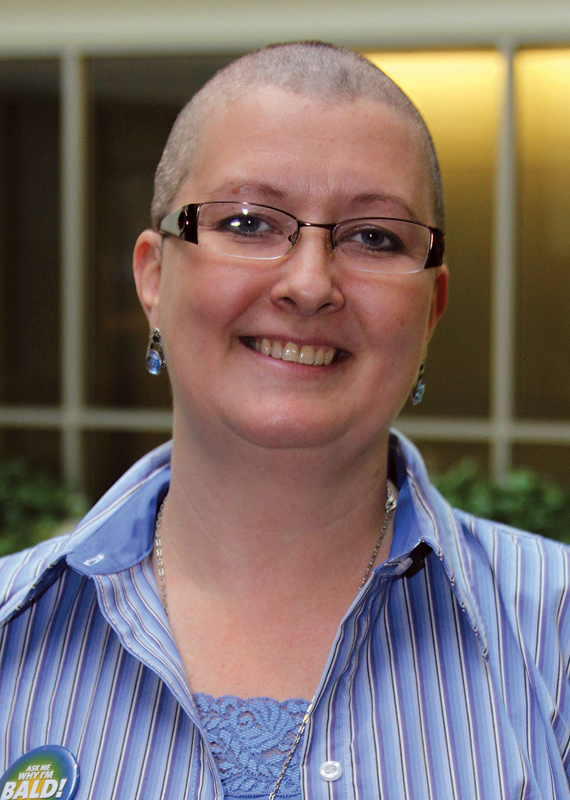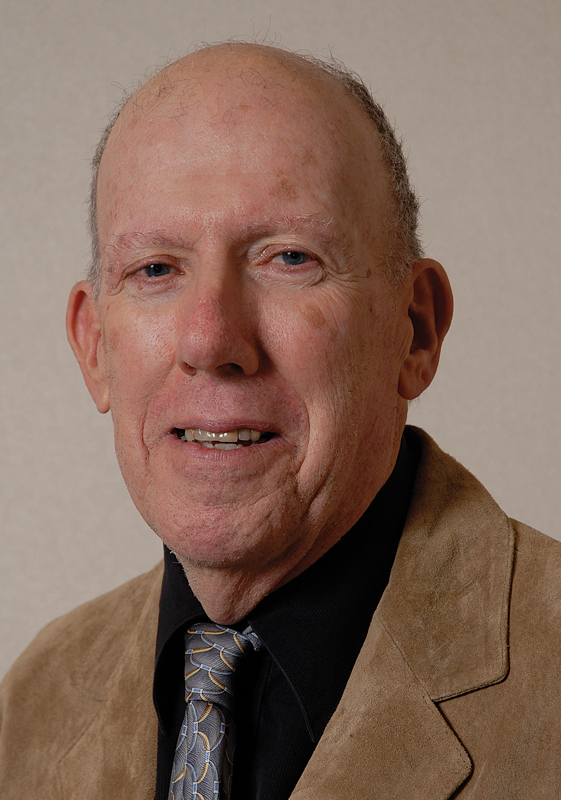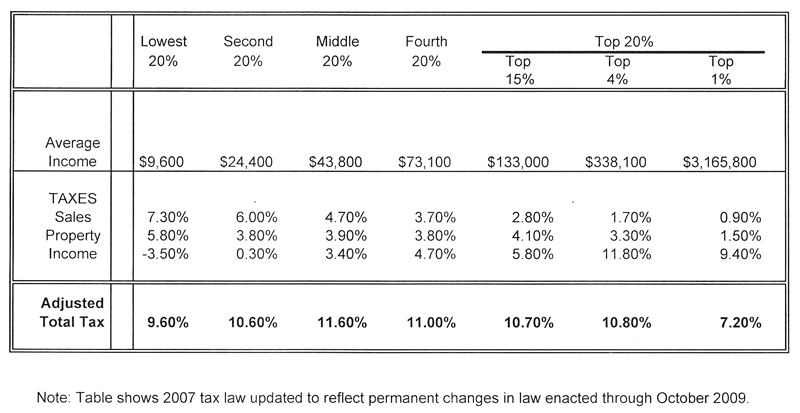|
When higher ed unionists in Florida appealed for help to bolster their ranks against political union-busting tactics, UUP was quick to answer the call. UUP Membership Development Officer Ed Quinn and Stony Brook Chapter President Arty Shertzer traveled to the Sunshine State in mid-April to help the United Faculty of Florida (UFF) recruit new members. A week later, Paul Stasior, an Upstate Medical University Chapter delegate, took five vacation days to head south and sign up new UFF members. Building up their numbers could be a matter of survival for UFF; Florida Republicans with Tea Party backing have pushed a bill that would decertify unions with less than 50 percent of its collective bargaining unit as members by July 1. The bill, HB 1023, is in committee, but labor leaders fear it could be passed at any time. The Republican majority in Tallahassee also is behind companion bills to bar unions from automatically deducting dues from an employee’s paycheck and to allow individual union members to call for a unit’s decertification. While Florida newspapers have reported that Gov. Rick Scott doesn’t have the votes in the current legislative session for the latter bills, union leaders expect the worst— particularly when it comes to HB 1023. ORGANIZE OR DIE “They know, that in a practical sense, this is a death penalty for unions,” UFF President Tom Auxter said of HB 1023. “The estimation is that more than half of the education unions in the state could be decertified if this anti-union legislation passes. It may be that we can win a court case in four years to overturn it, but by then, no one may be around to challenge the law.” “This is an attack and UFF is responding by growing the union,” said Shertzer. “That’s why we went to Florida, to help them fight back.” Auxter asked unionists for help in recruiting new UFF members at AFT’s national Higher Education Issues Conference in Philadelphia in April. So far, UUP, CUNY, and United College Employees, representing Fashion Institute of Technology employees, have provided aid. Unionists from Alabama have also helped out. The visits by UUP volunteers have injected momentum into the organizing drive, Auxter said. “We wouldn’t have this (recruitment) momentum without UUP’s help,” said Auxter. “People are joining the union and they’re cranked up and ready to move.” Quinn and Shertzer spent four days at Tampa’s University of South Florida campus, meeting with faculty and UFF leaders to shore up the union, which represents faculty at 22 public state universities and colleges, and three independent universities. Stasior spent five days working with UFF union members at the University of Florida, one of eight UFF chapters with less than 50 percent membership. The rest of UFF’s chapters are at or above the threshold, Auxter said. “I believe that we need union representation,” said Stasior, explaining why he made the trip. “Unions aren’t perfect, but they are necessary because workers need checks and balances with management and they need them with us.” RIGHT TO WORK UUPers quickly realized that it’s harder to recruit new unionists in Florida than in New York. Unlike New York, Florida has a right-to-work law. That means that in Florida, workers cannot be compelled to join a union and are not obligated to pay union dues—unless they join the union and agree to pay dues. However, non-union faculty receive the same rights and benefits as union members—gains negotiated by the UFF in its collective bargaining agreement with the state. “You’ve got to convince them that joining the union is going to be worthwhile, that the union is going to be stronger and be able to do more for membership if its numbers are bigger,” Quinn said. That was a tough sell because employees already get the same benefits as UFF members without paying union dues, which is 1 percent of their annual salary. Non- union members are also allowed to vote on union-negotiated contracts, Stasior said. “They’re giving (employees) all the rights of being in the union without joining the union,” Stasior said. GETTING IT AT LAST Still, Florida faculty members are beginning to understand the importance of being in a union, what with educators in Florida under fire, mainly from Republicans with Tea Party backing. Stasior said he signed up eight people during his trip and had interest from others who he expects will sign up soon. Quinn said he and Shertzer signed up a handful of employees on the spot; they were carrying union forms, something UFF members weren’t doing on their recruitment outings. Most faculty the pair spoke to were sympathetic to the union’s cause and said they had thought about joining, but weren’t ready to put their name on the dotted line. “There’s an attitude in Florida that questions the need to join the union,” said Shertzer. “But that’s starting to change because people are beginning to understand that these threats are real.” UUP-UFF CONNECTION While in Florida, Quinn and Shertzer shared membership development ideas and issues, and discussed the unions’ MDO recruitment programs. Quinn said UUP will continue to work and share union-building strategies with UFF. “These are just more attacks against public employee unions and we need to stop them wherever they appear,” Quinn said. “If these efforts succeed, they will affect us too. It is important to defend the rights of our members as well as the rights of all public employees.” — Michael Lisi |
Negotiations: Committee OKs contract proposals
|
UUP completed another phase of negotiations in late April, when the 35-member Negotiations Committee unanimously approved a package of bargaining proposals to be presented to the state. The contract between UUP and New York state expires July 1, and no talks were scheduled as The Voice went to press. The Negotiations Committee—which consists of one representative from each chapter, plus an at-large part-time professional and an at-large part-time academic—is constitutionally charged with formulating negotiations proposals for presentation to the UUP president. Now that the committee has approved UUP’s proposals, the Negotiations Team— under the direction of UUP President Phil Smith—can proceed with contract talks. The package of proposals approved at the April 29 joint meeting of the Negotiations Committee and Negotiations Team was developed in response to member input collected during UUP’s information-gathering phase that began last fall, and from Team meetings with UUP officers and NYSUT labor relations specialists assigned to UUP. During the joint meeting, UUP Chief Negotiator Jamie Dangler stressed that “everything the Negotiations Committee identified as a priority is included in the conceptual language we’ve prepared for the state. We’ve covered all the bases.” UUP’s contract proposals will be made public following the formal exchange of packages with the state. Dangler said the Team and Committee completed an exhaustive review of members’ suggestions and concerns regarding their terms and conditions of employment. The two groups worked together in January to prioritize the information gathered through Team visits to the chapters, a negotiations survey, member suggestion forms, and chapter and statewide committee reports. “The individuals who have volunteered for the challenging task of defining UUP’s contract priorities have done an excellent job listening and responding to members’ concerns,” Smith said. “Our members can feel confident in their union negotiators, and in the fact that their issues form the foundation of our proposals.” UUP’s proposals may be written and approved, but the Team won’t stop working until there’s a new collective bargaining agreement. “The Team will continue with its prep work—gathering information and anecdotes, strategizing, and finding the best ways to illustrate the problems our members face on campus and in the workplace,” Dangler said. How long that will take is anyone’s guess, but UUP has vowed not to negotiate in the press. UUP is closely monitoring contract talks with other state employee unions, some of whose contracts expired April 1. Members are reminded to watch the UUP? website—www.uupinfo.org—for updates. The second Negotiations Bulletin was posted in early May, and others will be issued when critical points are reached. Members can also contact Dangler at contract@uupmail.org for further information or to submit questions and comments. — Karen L. Mattison |
UUP front: Newsletters, website win NYSUT awards
|
The communications efforts of UUP’s two Stony Brook chapters, as well as the union’s retiree contingent, picked up a total of seven awards in the annual journalism and website competition sponsored by NYSUT United. Stony Brook HSC’s Bridges earned three awards, while the chapter website added a fourth. Bridges received Awards of Merit for: Best Feature Story, “Stony Brook home,” by Ian Hu; Best News Story, “President’s message” on bullying, by Kathy Southerton; and Best Opinion Writing, “Flu vaccines: The choice is now yours,” by Southerton. Pam White is the newsletter editor. Judges had only good things to say about the publication. “The story of the clinic is well written and gives readers a good look at the facility; the message on bullying is an excellent, well-written report that provides useful information in an easy-to-read format,” according to the judges. The opinion piece on flu vaccines “is a very complete, detailed and nontechnical explanation of the facts surrounding this important and timely issue.” The chapter also picked up an Award of Merit for Best Website. Bruce Kube is the webmaster. “The site is comprehensive and user-friendly,” the judges wrote. “It’s good to see video being used.” Stony Brook’s Insight earned an Award of Merit for Best Publication. The chapter newsletter is edited by Pam Wolfskill. “This is an excellent publication that truly gives its members a clear vision of the chapter’s mission, activities and interests,” the judges wrote. “The articles are well written and full of information, while the layout is attractive and easy to read.” The Active Retiree picked up a first-place award for Best Publication and an Award of Merit for Best News Story in the retiree competition. The judges were impressed with the overall publication. “Great layout, newsy content and nice graphics. A first-class publication.” Stony Brook retiree Judy Wishnia wrote the winning article, “Service Corps ‘re- imagines’ SUNY retirement,” on the inaugural conference of the SUNY Retiree Service Corps. “Great job on the establishment of a retiree service corps. Fine detail and great layout,” according to the judges. Judging the contest were Eric Krieger and Howard Healy, former editors for the Albany Times Union; and Elaine Cape, former assistant editor for the Daily Gazette. — Karen L. Mattison |
Briefly Equity study: UUP members urged to fill out online survey
|
UUPers are urged to take an online survey about the possibility that they are paid less based on their race or ethnicity. The UUP Task Force on Pay Equity Based on Race hopes the online survey—found at www.uupinfo.org—will provide them with enough data to see if such a situation exists at SUNY. According to task force member Charles Callahan III of Brockport, the project’s principal investigator, it is critical that as many members as possible answer the survey to create a data pool large enough to allow it to begin testing to see if inequalities exist. “We’re hoping people are willing to provide this crucial information so we can make reasonable inferences about the data we collect,” he said. Task force Chair Charles Hines of Stony Brook HSC said that personal information submitted in the survey is confidential and will be left out of the final report. Federal benefits: Payments go electronic —The U.S. Department of the Treasury recently announced that people applying for federal benefits on or after May 1 must choose an electronic payment method when they apply. Anyone currently receiving paper checks must switch by March 1, 2013. Those already receiving benefit payments electronically will continue to receive their payments as usual on their payment dates. More information is available online at www.godirect.org or by calling (800) 333- 1795. Help sought for storm victims—The Jefferson County American Federation of Teachers is looking for gift cards for clothing and essentials to help Alabama AFTers recover from the violent storms that ravaged Southern states April 27. Needed items include flashlights, batteries, radios, wet wipes, diapers, baby food, children’s underwear, hand sanitizer and garbage bags. Mail donations or gift cards, or order items online and have them shipped, to: JCAFT, c/o Vi Parramore, 1900 20th Ave. South, Birmingham, AL 35209. State pensions are underfunded —A new report on state pensions from the Pew Center on the States offers some lessons for dealing with the aftermath of the financial collapse. The report, “The Widening Gap: The Great Recession’s Impact on State Pension and Retiree Health Care Costs,” found that, in all, state pension systems in 2009 were slightly less than 78 percent funded—declining six percentage points from the 2008 level of 84 percent. “The good news in the Pew report is that … the plans showed resilience and an ability to weather the massive financial downturn,” AFT President Randi Weingarten said. The AFT Executive Council will review a new report from the union’s Ad Hoc Committee on Revenues and Retirement Security that focuses on long- term solutions to ensure retirement security for all, based on reality, not on misconceptions about workers’ pensions. The report can be found at http://bit.ly/k7LL8O. |
Leadership workshops: UUP prepares its leaders for the challenges ahead
|
Phil Smith remembered the day more than two decades ago when a colleague asked him to get active in his union as chapter grievance officer. Now he’s the head of the nation’s largest higher education union. UUP President Smith shared his introduction into UUP with nearly 100 budding union activists attending the Chapter Presidents/Vice Presidents Retreat and Spring New Leadership Workshops, held March 18-19 in Saratoga Springs. “I told my colleague that I had some legal experience,” Smith said. “That’s when he hooked me. “Now that we’ve hooked you, we’re going to reel you in.” He was kidding, of course, and got a hearty chuckle from the group. But Smith wasn’t fooling about the challenges UUP and its new leaders will face on many fronts, or how he will not hesitate to call on them to act and to motivate others on behalf of SUNY and UUP. “UUP is very concerned about the impact of ongoing cuts to SUNY’s operating budget, and how the elimination of all direct state aid to University hospitals would send the medical schools over the cliff with them,” Smith said. “You’ve taken the first step toward being a leader; we’re counting on you taking many more.” To that end, UUP hosted its spring training session to help members hone their skills and learn a little more about how their union operates. Chapter presidents and vice presidents headed into breakout sessions by campus type, while their newer cohorts attended workshops on problem solving, grievances, conquering bullying, and collective bargaining. The workshops were conducted by NYSUT labor relations specialists assigned to UUP. “Forums for Problem Solving” included an overview of the different categories that problems fall under, and how to deal with problems through the grievance procedure, an improper practice charge, a harassment complaint, or a labor/ management setting. “Manners Please: Conquering Bullying and Creating Civility in the Workplace” helped members identify bullying behaviors and use available approaches to resolve the problem. The “Grievance” workshop covered the procedural requirements of UUP contract articles 7 and 19. There was also a discussion on the union’s duty of fair representation. “Collective Bargaining and the Taylor Law” provided an overview of the Public Employees Fair Employment Act, which provides the legal basis for implementing collective bargaining for public employees. — Karen L. Mattison |
Our givebacks: Hair today; gone tomorrow, and all for a very good cause
|
Jeriluanne O’Bryan-Losee thought that shaving her head would be a great way to thumb her nose at turning 40. She had no idea how many lives she’d touch by that act. The Morrisville UUPer had her shoulder-length locks sheared to half-inch stubble in March—three days before her 40th birthday—at an annual “hair shaving” event in Norwich to generate donations for the St. Baldrick’s Foundation, a California-based non-profit that supports childhood cancer research. A local newspaper story publicizing her hair-cutting plans appeared a few weeks before the event, which helped her raise $1,700 in donations. A few days after the story ran, an odd, misaddressed package arrived at O’Bryan-Losee’s house. Inside was a pink and brown knit cap, sent by a woman who crochets them for people undergoing chemotherapy. The woman, who lost her husband to cancer, had read about O’Bryan-Losee’s plans and wanted her to have a cap in appreciation for her hair sacrifice. “It really made me think because here I am having fun with this and making a statement, but it’s allowing her to keep her husband’s memory alive,” said O’Bryan- Losee, whose late father and father-in-law had cancer. “If the $1,700 makes a difference, that would be wonderful. But realizing that this little act reached so many people, it really blows my mind.” MAKING A DIFFERENCE At first, O’Bryan-Losee’s reasons for getting her head shaved were more about saying hello to 40 with panache than making a statement about cancer. But things changed in the days leading up to the event. “I got so much feedback and that’s the part of this that’s precious to me,” she said. “People who I didn’t know had been sick reached out to me. I got an e-mail from a student who lost a daughter to cancer thanking me for doing it.” “I’m lucky, my hair will grow back,” she continued. “But there are a lot of people who don’t have the option.” That’s not to say that she didn’t think twice before getting her scalp buzzed. Fortunately, she wasn’t alone; Morrisville UUPer Matthew Barber, her sister, Lynnbeth, and several Morrisville students also had their heads shaved for the good cause. SHOCK AND ‘AWW’ And she got an extra bang for her bangs; besides her donation to St. Baldrick’s, O’Bryan-Losee’s hair was donated to Locks of Love, an organization that makes donated hair into hairpieces for children with cancer who lose their hair. She also got plenty of shock value out of her new ’do. O’Bryan-Losee, a UUP Finance Committee member, was at a committee meeting in Albany the night before the hair-shaving event. She left to get her hair chopped and returned to Albany for a Sunday afternoon meeting. “I only had one day’s growth; it was a 5 o’clock shadow. It felt very strange,” she said, laughing. The committee passed the hat and raised nearly $200 more for the foundation. While O’Bryan-Losee was glad to donate her time and hair to St. Baldrick’s, chances are she won’t repeat the scene next year. One buzz cut is enough. “I would definitely raise money again for cancer, but I don’t know if I have the guts to shave my head again,” she said. — Michael Lisi |
Spotlight shines on UUP members
In other words: VP for Academics Fred Floss We need a progressive tax system
|
In the current debate on New York state taxes, the elephant in the room is fairness. Are we treating retired property taxpayers fairly? Are school taxes too high on Long Island compared with the rest of the state? Are millionaires and corporations paying their fair share? Are millionaires’ concerns more important than our children’s education? In most cases, the debate centers on egregious examples. For instance, in Buffalo, a millionaire lawyer buys a million dollar condominium but pays no property taxes because of an Empire Zone Tax Credit, a savings worth $260,000 over the 10 years of the credit. At the same time, just blocks away, a middle-class family must pay full taxes on a $60,000 home. The builders of the project supported the tax break, saying, “It was the only way the project made economic sense.” But what does this say about the fairness of the system as a whole and how it should be changed? One dictionary definition of fairness states: free from favoritism, self-interest or preference in judgment. This is the common sense definition that most of us have in our heads when we talk about taxes. Tax theorists have long tried to deal with the many concepts of tax fairness. Is horizontal theory (treating individuals in the same category) or vertical theory (treating individuals in different categories) more important? How do we treat intergenerational tax burdens? Should we look at taxes for an individual in a single year or over a lifetime? What about regional differences? Should we make allowances for high-cost areas? In each case, a good argument for using one category over the other to talk about tax fairness is possible. In each case, one group of New York state residents will be helped and another hurt. One way philosophers get around these problems is to use what they call the “veil of ignorance.” In other words, if you were unaware of your economic status, what type of tax system would you choose? This is the reasoning behind conservative Chicago professors Blum and Kalven in their book, The Uneasy Case for Progressive Taxation. They argue the value of progressive taxes based on “distributive justice.” Put simply, the authors argue that people who make more money, have a greater ability to pay and who benefit the most from government should pay more taxes. For Blum, Kalven and most of their readers in 1952, this was obvious. Today, the rich try to confuse the argument of justice and turn to efficiency as the measure as if more goods for fewer people is a just outcome for society. So, if a progressive tax system at some level is important to having a fair tax system, how does New York stack up? Even with the current millionaire’s tax in place, the Institute on Taxation and Economic Policy calculates the top 1 percent of New York State taxpayers pay 4.4 percent less as an effective tax rate than the middle 20 percent of New Yorkers. In fact, the top 20 percent pay a lower rate on their income than the lowest 20 percent, who make less than $16,000 per year. The table below shows the entire distribution. How many New Yorkers understand that we have a regressive system that taxes the poor more than the rich? Would knowing this change the public debate? UUPers are members of the working class, and the working class deserves to be treated fairly. It is our job to ask these tough questions and to bring the taxation discussion back to the issue of justice. New York State and Local Taxes in 2007 |
Let NYSUT Member Benefits put a smile on your face this summer
|
Are you planning a beach getaway or a cruise to an exotic location? Looking to plan an all-inclusive trip? Let NYSUT Member Benefits help. Need a hotel or car rental? We’ve got you covered. Want that special book or magazine for some summer reading? We can help with that, too. Being a UUP/NYSUT member brings with it many advantages and benefits— including the opportunity to take part in any of our endorsed discount programs. NYSUT Member Benefits offers a variety of discount programs designed to make your life easier and put a smile on your face. The following is just a sampling of some of the discount programs available to you: TripMark.travel Wyndham Hotels and Vacation Rentals Car Rental Discounts Motivano SmartSavings Online Discount Marketplace Working Advantage Buyer’s Edge, Inc. Six Flags Discounts Powell’s Books AFT Subscription Services—Discover the lowest rates on subscriptions to your favorite magazines, such as Newsweek, Time and Sports Illustrated. We also endorse a number of quality, competitive insurance plans and benefit programs—such as life insurance, disability insurance, catastrophe major medical insurance, and financial and legal services—designed to assist you throughout the year. Many of these programs are available to or cover spouses/domestic partners of members, dependent children, and dependent parents and grandparents. NYSUT Member Benefits welcome your feedback on our programs and services. Visit www.memberbenefits.nysut.org for a complete listing of opportunities available to you. (For information about this program or about contractual endorsement arrangements with providers of endorsed programs, please contact NYSUT Member Benefits at 800-626-8101 or visit www.memberbenefits.nysut.org. Agency fee payers to NYSUT are eligible to participate in NYSUT Member Benefits-endorsed programs.) |
Start your ‘search engines’ for your benefits at a glance
|
Being a member of UUP has numerous advantages. Our members have access to discounted programs from UUP and several of our affiliates. Listed below are some of the benefits available through the AFL-CIO, the American Federation of Teachers (AFT), the National Education Association (NEA) and New York State United Teachers (NYSUT). Start your search engines and embark on a virtual tour of the benefits available to you and your eligible dependents. AFL-CIO—Browse the AFL-CIO website at www.afl-cio.org and you’ll find low- interest credit cards, scholarships, mortgages, legal services and much more. There is also an AFL-CIO online store where you can purchase union-made items such as T-shirts, hats, buttons, coffee mugs, lapel pins and more. AFT—AFT+ Member Benefits at www.aft.org/aftplus offers some unique programs, such as moving van discounts, the “Save My Home” hotline, home health care products, pet insurance and Pet Assure veterinary care savings. There are also many discounts from retailers for products and services ranging from hotels and vacation rentals to entertainment and health clubs. NEA—With just a click at www.neamb.com, you will find everyday savings on auto purchases, Costco membership, theft protection, credit card reward programs, and the Whirlpool Corporation VIPLINK program. Discounts are also available on health and wellness programs, books and magazines, car rentals, and travel and tours. Eligible members also can take advantage of the valuable, automatic term life insurance coverage provided by NEA complimentary life insurance, provided at no cost to active, staff, reserve and life members for: Up to $1,000 of term life insurance; up to $5,000 of accidental death and dismemberment coverage; up to $50,000 of AD&D insurance for any covered accident that occurs while on the job or serving as an association leader; and up to $150,000 of life insurance for unlawful homicide while on the job. Go online to check your eligibility and, while you’re there, don’t forget to name a beneficiary. NYSUT—Surf your way to NYSUT at www.memberbenefits.nysut.org. Here you will find a long list of retail discounts and other programs, such as a legal service plan, consumer credit counseling, EPIC hearing service plan, Lifeline medical alert, and dozens of insurance programs. UUP—At www.uupinfo.org, you will find all your negotiated benefits through the Benefit Trust Fund, such as dental, vision, scholarship, and life insurance. There are also a number of services through the UUP Member Services Trust Fund, including discounts from AT&T, Crystal Rock bottled water, Bally Total Fitness, Enterprise, Hewlett Packard, Goodyear tires, OfficeMax, Sprint, Verizon and more. On behalf of the UUP Benefit Trust Fund, I would like to wish our members a safe and enjoyable summer. — Doreen Bango, UUP Manager of Member Benefits and Services |


